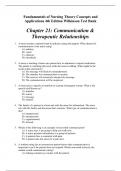Exam (elaborations)
Fundamentals of Nursing Theory Concepts and Applications 4th Edition Wilkinson Test Bank |Chapters 21-25|
- Course
- Institution
Chapter 21: Communication & Therapeutic Relationships Chapter 22: Health Assessment Chapter 23: Promoting Asepsis & Preventing Infection Chapter 24: Promoting Safety Chapter 25: Facilitating Hygiene
[Show more]



